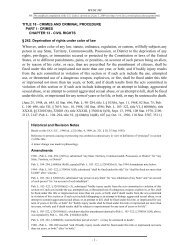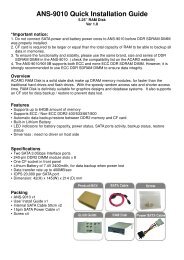2004 Instructions for Form 1040 (ALL) - Supreme Law Firm
2004 Instructions for Form 1040 (ALL) - Supreme Law Firm
2004 Instructions for Form 1040 (ALL) - Supreme Law Firm
You also want an ePaper? Increase the reach of your titles
YUMPU automatically turns print PDFs into web optimized ePapers that Google loves.
gross income was over $139,500 ($69,750<br />
if married filing separately).<br />
• You could not deduct all of the<br />
amount on the 2003 Itemized Deductions<br />
Worksheet, line 1.<br />
• The amount on line 8 of that 2003<br />
worksheet would be more than the amount<br />
on line 4 of that worksheet if the amount on<br />
line 4 were reduced by 80% of the refund<br />
you received in <strong>2004</strong>.<br />
Line 11<br />
Alimony Received<br />
Line 12<br />
Business Income or (Loss)<br />
If you operated a business or practiced your<br />
profession as a sole proprietor, report your<br />
income and expenses on Schedule C or<br />
C-EZ.<br />
Line 13<br />
Capital Gain or (Loss)<br />
Enter amounts received as alimony or separate<br />
maintenance. You must let the person<br />
who made the payments know your social<br />
security number. If you do not, you may<br />
have to pay a $50 penalty. For more details,<br />
use TeleTax topic 406 (see page 8) or see<br />
Pub. 504.<br />
If you had a capital gain or loss, including<br />
any capital gain distributions or a capital<br />
loss carryover from 2003, you must complete<br />
and attach Schedule D.<br />
Exception. You do not have to file Sched-<br />
ule D if both of the following apply.<br />
• The only amounts you have to report<br />
on Schedule D are capital gain distributions<br />
from <strong>Form</strong>(s) 1099-DIV, box 2a, or substitute<br />
statements.<br />
• None of the <strong>Form</strong>(s) 1099-DIV or<br />
substitute statements have an amount in<br />
box 2b (unrecaptured section 1250 gain),<br />
<strong>Form</strong> <strong>1040</strong>—Lines 10 Through 13<br />
box 2c (section 1202 gain), or box 2d (collectibles<br />
(28%) gain).<br />
If both of the above apply, enter your<br />
total capital gain distributions (from box 2a<br />
of <strong>Form</strong>(s) 1099-DIV) on line 13 and check<br />
the box on that line. If you received capital<br />
gain distributions as a nominee (that is,<br />
they were paid to you but actually belong to<br />
someone else), report on line 13 only the<br />
amount that belongs to you. Attach a state-<br />
ment showing the full amount you received<br />
and the amount you received as a nominee.<br />
See the <strong>Instructions</strong> <strong>for</strong> Schedule B <strong>for</strong> filing<br />
requirements <strong>for</strong> <strong>Form</strong>s 1099-DIV and<br />
1096.<br />
If you do not have to file Sched-<br />
TIP ule D, be sure you use the Qual-<br />
ified Dividends and Capital<br />
Gain Tax Worksheet on<br />
page 34 to figure your tax. Your tax may be<br />
less if you use this worksheet.<br />
State and Local Income Tax Refund Worksheet—Line 10<br />
Keep <strong>for</strong> Your Records<br />
1. Enter the income tax refund from <strong>Form</strong>(s) 1099-G (or similar statement). But do not enter more than<br />
the amount on your 2003 Schedule A (<strong>Form</strong> <strong>1040</strong>), line 5 ................................. 1.<br />
2. Enter your total allowable itemized deductions from your 2003 Schedule A (<strong>Form</strong><br />
<strong>1040</strong>), line 28 .................................................... 2.<br />
Note. If the filing status on your 2003 <strong>Form</strong> <strong>1040</strong> was married filing separately and<br />
your spouse itemized deductions in 2003, skip lines 3, 4, and 5, and enter the<br />
amount from line 2 on line 6.<br />
3. Enter the amount shown below <strong>for</strong> the filing status claimed on<br />
your 2003 <strong>Form</strong> <strong>1040</strong>.<br />
• Single or married filing separately— $4,750<br />
}<br />
• Married filing jointly or qualifying widow(er)— $9,500 . . 3.<br />
• Head of household— $7,000<br />
4. Did you fill in line 36a on your 2003 <strong>Form</strong> <strong>1040</strong>?<br />
No. Enter -0-.<br />
}<br />
Yes. Multiply the number in the box on line 36a of your<br />
2003 <strong>Form</strong> <strong>1040</strong> by: $950 if your 2003 filing status<br />
was married filing jointly or separately or qualifying 4.<br />
widow(er); $1,150 if your 2003 filing status was<br />
single or head of household.<br />
5. Add lines 3 and 4 ................................................. 5.<br />
6. Is the amount on line 5 less than the amount on line 2?<br />
No. None of your refund is taxable.<br />
STOP<br />
Yes. Subtract line 5 from line 2 ................................................. 6.<br />
7. Taxable part of your refund. Enter the smaller of line 1 or line 6 here and on <strong>Form</strong> <strong>1040</strong>, line 10 7.<br />
-21- Need more in<strong>for</strong>mation or <strong>for</strong>ms? See page 7.













